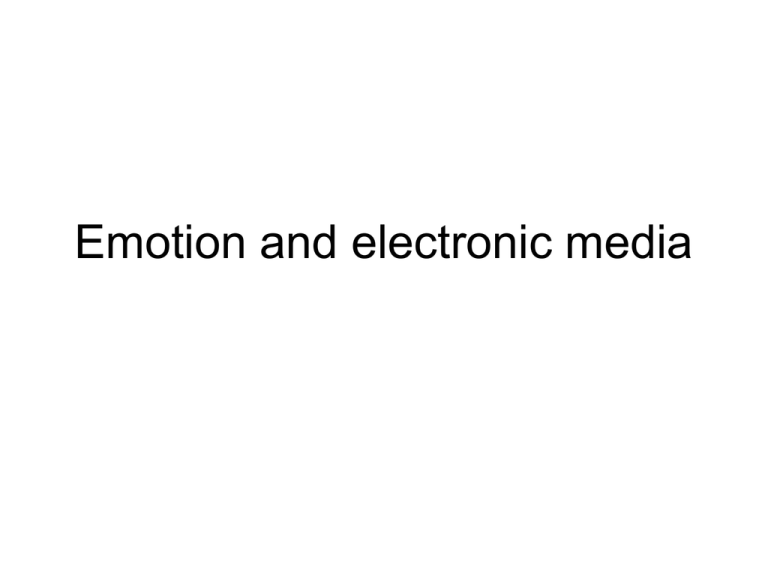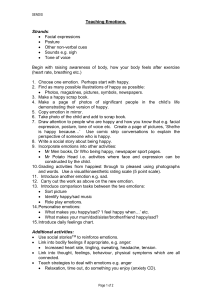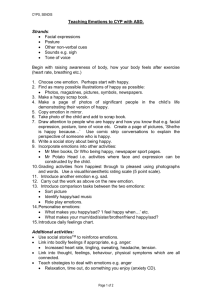Emotion_and_media
advertisement

Emotion and electronic media What is emotion? • Robert Masters makes the following distinctions between affect, feeling and emotion: "As I define them, affect is an innately structured, noncognitive evaluative sensation that may or may not register in consciousness; feeling is affect made conscious, possessing an evaluative capacity that is not only physiologically based, but that is often also psychologically (and sometimes relationally) oriented; and emotion is psychosocially constructed, dramatized feeling.“ • Source: Wikipedia • Emotions are physical expressions, often involuntary, related to feelings, perceptions or beliefs about elements, objects or relations between them, in reality or in the imagination. • In the Triune brain model, emotions are defined as the responses of the Mammalian cortex. Emotion competes with even more instinctive responses from the Reptilian cortex and the more logically developed neocortex. What defines which emotion we are feeling? • Miron: The dedicate neural pathway that is being stimulated. – Different pathways are excited depending upon the emotion in question. However, some are quite similar and therefore have to be defined by the individual as one emotion rather than another (anger v. fear) Why haven’t emotions been replaced with higher order thinking? • Miron, etc.: Survival value maintained anger, sorrow, love, fear, etc. until civilization, etc. There are still advantages for several of the emotions in that they provide coherence of thought, feeling and action in regards to general situations— anger for frustration, love for sexuality and nurturance, fear for self-preservation in the face of a threat. Where do they come from? • Are they innate or are they learned? •Yes!!! Innate emotions • There are said to be a few emotions that are hard-wired into our brains. The socalled “fight or flight” reactions are considered by most to be “basic” – Fear – Anger • Adaptive in that they provide a burst of energy and quick reaction to threat or frustration Social emotions • Emotions that allow you to interact with others effectively and to maintain social bonds – Love – Friendship – Empathy • Learned early through the positive relationships between mom and food, etc. • Located in higher mammalian brain The experience of emotion • Psychophysiological effects are often “autonomic” in that they do not require thinking – Often override more logical, evaluative brain functions when the emotional intensity is high – Feelings are learned along with situations, people, etc. – Similar people or situations may bring about the same feelings and the same feelings may bring about memories of the situations or people they were encoded with • The body frequently responds to Shame by warmth in the upper chest and face, Fear by a heightened heartbeat, increased "flinch" response, and increased muscle tension. The sensations connected with anger are nearly indistinguishable from fear. Happiness is often felt as an expansive or swelling feeling in the chest and the sensation of lightness or buoyancy, as if standing underwater. Sadness by a feeling of tightness in the throat and eyes, and relaxation in the arms and legs. Desire can be accompanied by a dry throat and heavy breathing. • Source: Wikipedia • Ekman found that at least some facial expressions and their corresponding emotions are not culturally determined, but universal to human culture and thus biological in origin, as Charles Darwin had once theorized. Ekman's finding is now widely accepted by scientists. Expressions he found to be universal included anger, disgust, fear, joy, sadness and surprise. Findings on contempt are less clear, though there is at least some preliminary evidence for its being universally recognized. Universal facial expressions of emotions • Ekman et al. (1972; see PIP p.146) suggests six emotions can be detected in faces: • Happiness. • Surprise. • Anger. • Sadness. • Fear. • Disgust/contempt. Abraham Maslow Why are we drawn to emotional content? • Miron: All arousal (emotions have a component that is arousal) is inherently pleasurable – The main driving force for human action is to seek pleasure and avoid pain • Zillmann: We enjoy watching the good guys rewarded and the bad guys punished. The enjoyment is enhanced by the wrong thing happening prior to an appropriate conclusion Why are we drawn to emotional content? • Some emotions generate positive feelings through natural ‘drugs’ (dopamine) released as part of emotional processing • Emotions are encoded along with cognitions, perceptions, behaviors and outcomes. When the outcomes are rewarding, the emotions become tied to them and are called up at appropriate future times—especially when a lack of some important condition is identified (food, warmth, sex) • Freud: Sublimated base drives continually emerge from unconscious, can better be played out in observing others engaging in animalistic behavior—you don’t risk the societal consequences yourself Okay, so why would simply watching someone else stir my emotions? • Empathy – Zillmann: An understanding of the constraints/conditions of another leads to sympathy for them – XXXX: Place yourself in the position of the character and imagine the conditions happening to you – Mirror neurons —you don’t know the difference between yourself acting and another acting What parts of a presentation have an effect on my emotions? • Snakes, spiders, attacking wild animals, etc. • Faces—just as they are universal, faces are also especially compelling in generating an emotional effect • Action • Voice • Music • Loss—especially of a loved one (even when depicted) Major emotions • Sadness/sorrow – Sources: • Loss of significant other/love/affiliation • Empathy for those in pain/poor circumstance • Anger – Frustration – Control by outside force • Fear – Threat • Darkness, snakes and spiders • Socially-learned fears







